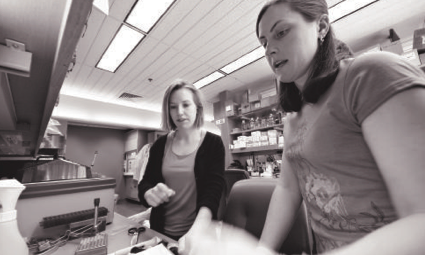 Muscular dystrophy (MD) is a group of diseases that cause the voluntary muscles of the body to become progressively weaker, resulting eventually in a loss of mobility. What makes MD especially tragic is that it usually strikes the young and, as yet, there is no effective treatment.
Muscular dystrophy (MD) is a group of diseases that cause the voluntary muscles of the body to become progressively weaker, resulting eventually in a loss of mobility. What makes MD especially tragic is that it usually strikes the young and, as yet, there is no effective treatment.
A number of researchers within HSCI are striving to better understand MD in all its forms with the ultimate goal of finding a cure. One scientist involved in this effort is HSCI Principal Faculty member Amy Wagers, PhD, principal investigator in Developmental and Stem Cell Biology at Joslin Diabetes Center. Wagers’ lab focuses on identifying and characterizing tissue-specific stem cell populations in adult animal models that might be marshaled to support the repair of non-blood tissue, including muscle, in diseases such as MD.
In 2005, the Jain family of New York State established the Jain Foundation to help find a cure for rare forms of MD called LGMD2B/Miyoshi, which are caused by a lack of the protein dysferlin. Greatly impressed by Wagers and the promise of her work, the Jain Foundation is providing two years of funding for a research project that may lead to the identification of factors circulating in the blood that could improve the symptoms of forms of MD caused by a dysferlin deficiency, also called dysferlinopathies.
“Dr. Wagers gave us one of the best proposals we have received, and we’re very excited about the successes she’s had,” says Jain Foundation President Plavi Mittal, PhD.
Wagers’ project is exploring whether exposing dsyferlin-deficient mice at different stages of muscle degeneration to the systemic environment of unaffected young mice will improve muscle regeneration. Wagers explains that this is done using a “powerful technique” called parabiosis, in which two animals are surgically joined so they develop a common circulatory system, giving the diseased animals exposure to all of the factors circulating in the unaffected animals’ blood. This technique has already shown that the regenerative capacity of skeletal muscle in aged mice can be improved by exposure to the systemic environment of young mice.
“Funding from the Jain Foundation is allowing us to use existing technology in a new direction and giving us the additional hands to study this disease,” says Wagers, adding that the foundation also provided access to animal models for this research. The ultimate goal of this funding is to find a treatment or cure for LGMD2B/Miyoshi, which may also have relevance to other dysferlinopathies.
“The interest and support of this international foundation is a recognition of the unique strengths of the HSCI Muscle Program, and will help significantly in advancing our mission to develop new stem cell-based treatments for muscle disease,” says Wagers. “We are very grateful for the Jain Foundation’s support.”
